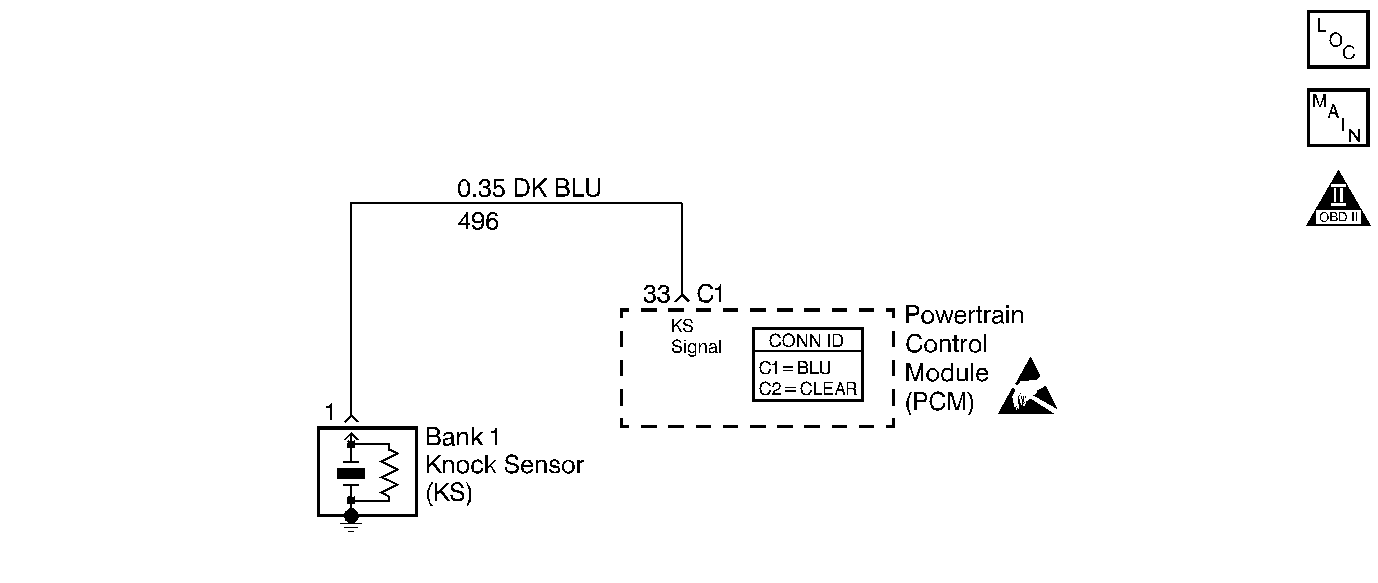
Circuit Description
The Powertrain Control Module (PCM) contains integrated knock sensor (KS) diagnostic circuitry. Input signals from the knock sensors are used to detect engine detonation, allowing the PCM to retard ignition control (IC) spark timing based on the amplitude and frequency of the KS signal being received. The KS produce an AC signal under all engine operating conditions. During engine operation, the PCM calculates the average voltage of each KS signal. If the KS system is operating normally, the PCM should monitor KS signal voltages varying over 0.5 volt above and below the calculated average voltage. If the PCM malfunctions in a manner which will not allow proper diagnosis of the KS circuits, DTC P0325 will set.
Conditions for Running the DTC
| • | No TP sensor, VSS, CKP, MAF, or ECT DTCs are set. |
| • | Engine speed is between 1000 and 4000 RPM. |
| • | Throttle angle is more than 15 percent. |
| • | Engine load is more than 45 percent. |
| • | Engine coolant temperature (ECT) is more than 60°C (140°F). |
| • | Maximum spark retard is less than 15 degrees. |
| • | System voltage is more than 9 volts. |
Conditions for Setting the DTC
| • | The PCM detects a malfunction in the integrated KS diagnostic circuitry which will not allow proper diagnosis of the KS circuits. |
| • | The above conditions are for at least 30 second. |
Action Taken When the DTC Sets
| • | The PCM will not illuminate the malfunction indicator lamp (MIL). |
| • | The PCM will store conditions which were present when the DTC set as Failure Records data only. This information will not be stored as Freeze Frame data. |
| • | The PCM will use a calculated spark retard value to minimize knock during conditions when knock is likely to occur. The calculated value will vary based on engine speed and load. |
Conditions for Clearing the MIL/DTC
| • | A history DTC will clear after 40 consecutive warm-up cycles have occurred without a malfunction. |
| • | DTC can be cleared by using the scan tool Clear Info function or by disconnecting the PCM battery feed. |
Test Description
The numbers below refer to the step numbers on the diagnostic table.
-
Ensures that the malfunction is present.
-
This vehicle is equipped with a PCM which utilizes an electrically erasable programmable read only memory (EEPROM). When the PCM is replaced, the new PCM must be programmed.
Step | Action | Values | Yes | No |
|---|---|---|---|---|
1 | Did you perform the Powertrain On-Board Diagnostic (OBD) System Check? | -- | ||
|
Important:: If an engine knock can be heard repair the engine mechanical problem before proceeding with this diagnostic. Refer to Engine Noise Diagnosis in Engine Mechanical.
Does the scan tool indicate this DTC failed this ignition? | -- | |||
3 |
Does the scan tool indicate this DTC failed this ignition? | -- | Go to Diagnostic Aids | |
|
Important:: The replacement PCM must be programmed. Replace the PCM. Refer to Powertrain Control Module Replacement/Programming . Did you complete the replacement? | -- | -- | ||
5 |
Does the DTC reset? | -- | System OK |
